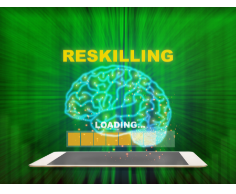5 Core Strategies and Tactics for Effective Virtual Classroom Programs
Upskilling the “new normal” virtual world is no longer a “nice to have” but a matter of survival. Many facilitators learned the hard truth that...
5 min read
 Karen Vieth
:
Aug 5, 2024 8:00:00 AM
Karen Vieth
:
Aug 5, 2024 8:00:00 AM

Incorporating active and sustainable learning principles into L&D can significantly improve the processes of evaluation. Organizations will have evaluative data that makes sense on the basis of the real impact of their training programs, which will allow for better progress toward organizational goals.
Evaluation practices in Learning and Development (L&D) are crucial for a few reasons:
Continuous Improvement: Evaluation practices offer invaluable insights into what is effective and what is not. The L&D community can then continue reviewing these courses to ensure they are appropriate and functional.
Evidence-Based Practices: Solid evaluation techniques make the L&D community’s strategies more informed, as opposed to being based on assumptions only.
Resource Allocation: Effective evaluations ensure that investment in training programs is worth it. They help make sure resources are allocated into implementing the initiatives with the most benefit.
Professional Validation: Strong evaluations give credibility to people working in the L&D professional disciplines and celebrate their efforts.
Through creative evaluation techniques, L&D professionals are able to guarantee that their training programs not only are captivating but also result in application in real life and improvements on performance. Evaluation ensures that the training provided matches with organizational goals and objectives. Better evaluation can allow for strategic adjustments, improved alignment with objectives, and more efficient budget allocations toward high-impact areas while reducing waste.
As organizations move from traditional classroom-based teaching to more dynamic digital learning environments such as e-learning, virtual platforms, and microlearning, there is an increasing need for a strong evaluation framework to ensure the effectiveness and return on investment (ROI) of L&D initiatives.
Evaluation helps to identify any learning gaps, measure the impact of training programs, and align them with business objectives. The use of data analytics together with feedback mechanisms enables organizations to continuously improve their L&D strategies, thus fostering a continuous learning culture responsive to both employees’ needs and those of the business.
There are three main elements that are key to developing more meaningful metrics in L&D: dynamic facilitation, compelling design, and essential support. Dynamic facilitation ensures that learning experiences are interactive and responsive to participants’ needs, thereby promoting engagement and active participation. Compelling design incorporates visually appealing, user-friendly, and relevant content that captures the attention of learners, allowing them to enhance their understanding through practice. Essential support provides learners with the resources, personal guidance, and feedback for them to succeed.
All these elements put together create a rich learning environment for generating diverse and insightful data. This data further supports the development of more precise and useful metrics through reflecting not only performance but also learners' involvement and satisfaction as well as their overall learning experience.
Active learning involves learning through activities such as discussions, problem-solving, or hands-on experiences. It is not like passive traditional learning where learners just get taught. In active learning, learners actively participate and think critically while working with their colleagues. This approach encourages self-regulated learning, resulting in better comprehension and retention of knowledge. By enabling learners to take part in meaningful activities and to apply concepts in real-life situations, active education enables them to be independent thinkers, work as efficient problem solvers, and have a long-term memory.
Sustainable learning concentrates on how well information can be recalled beyond the period of instruction as well as its practical use, ensuring that learners can effectively recall and use information long after they first learn it. Continuous reinforcement, practice, and reflection enable learners to internalize concepts deeply so that they can transfer them to different contexts. Methods of sustainable learning include repetition, real-world practice, and giving and receiving continuous feedback. Approaches such as these help reinforce understanding, thus maintaining skills over time.
Well-designed learning materials are important for effective training programs as they enhance clarity, engagement, and retention of the content. High-quality materials are structured to align with learning objectives, incorporate visual and interactive elements, and cater to various learning preferences. Thoughtful design ensures that content is accessible and engaging, helping learners grasp and apply knowledge more effectively. By presenting information in a clear, organized, and visually appealing manner, well-designed materials allow for a more impactful and memorable learning experience, ultimately leading to better training outcomes.
Compelling design includes several elements including visual appeal, clarity and structure, and relevance. Visual appeal involves using engaging graphics, color schemes, and layout techniques to capture and maintain learners' attention. Visual appeal includes incorporating images, infographics, and interactive elements that enhance the learning experience. Clarity and structure ensure that content is presented in a logical and organized manner, making it easier for learners to follow and understand. It involves clear headings, concise language, and a well-organized flow of information. Relevance ensures that the content directly aligns with learners' needs and real-world applications, making it meaningful and immediately applicable.
Engaging content plays a pivotal role in enhancing learner engagement, which in turn provides more accurate data for evaluation. When content is interactive, relevant, and stimulating, it captures learners' attention and motivates them to actively participate in the learning process. This increased engagement leads to deeper involvement, more thoughtful responses, and a better understanding of the material. As learners become more engaged, they provide richer and more detailed feedback, which offers a clearer picture of their learning experiences and outcomes. The data collected from more engaged learners is more reliable and reflective of their true performance and comprehension.
Successful training relies on several support mechanisms to hit the ground running: technical support, mentorship, and additional resources. Technical support ensures that learners have access to assistance with technological tools and platforms, helping them navigate any issues that arise during training. Mentorship provides personalized guidance and feedback from experienced individuals, offering insights, encouragement, and support tailored to learners' specific needs. Additional resources, such as supplementary reading materials, practice exercises, and online forums, enhance the learning experience by providing extra practice and information beyond the core content. Together, these support mechanisms help create a more comprehensive and effective training environment, addressing various challenges and facilitating deeper learning and skill development.
When learners have access to real-time technical support, they can resolve issues swiftly, minimizing disruptions and maintaining focus on their learning goals. Support significantly impacts learner success and the overall effectiveness of training programs by ensuring that learners have the resources and assistance needed to thrive. When support mechanisms are in place, learners are better equipped to overcome challenges, engage more deeply with the content, and apply their knowledge effectively.
This support fosters a positive learning environment where learners feel valued and motivated, leading to higher completion rates, improved performance, and greater skill acquisition. Training programs become more effective as they are able to produce measurable outcomes and demonstrate a higher ROI.
Moving beyond traditional metrics like completion rates and test scores is essential to gain a more comprehensive understanding of training effectiveness. While these metrics provide basic information about learner participation and initial knowledge acquisition, they often fail to capture the deeper, more nuanced aspects of learning, such as learner engagement, the application of skills in real-world contexts, and long-term retention.
By incorporating advanced metrics such as behavioral changes, performance improvements, and feedback from learners and stakeholders, organizations can better assess the true impact of their training programs. This shift toward more holistic evaluation methods allows for a more accurate measurement of training outcomes, helping to tailor and refine programs to meet both learner needs and business objectives.
A combination of quantitative (performance improvement, engagement levels, knowledge retention) and qualitative (learner feedback, behavioral changes, application of skills) metrics provides a holistic view of training effectiveness by capturing a range of data points beyond basic completion rates and test scores. By analyzing these diverse metrics, organizations can gain a comprehensive understanding of how well training programs meet objectives and impact learners' development. This in-depth analysis helps identify strengths and areas for improvement, allowing for data-driven decisions to enhance training content, delivery methods, and overall strategy. Continuous monitoring and evaluation of these metrics enable ongoing refinement and adaptation of training programs.
Comprehensive evaluation practices in L&D are crucial for ensuring that training programs are effective, efficient, and aligned with organizational goals. They provide comprehensive insights into various aspects of the learning experience, including learner engagement, knowledge retention, skill application, and overall impact on performance. By systematically assessing these elements, organizations can identify strengths, uncover areas for improvement, and make informed decisions about program enhancements.
Integrating active and sustainable learning principles is also important to enhance evaluation practices within L&D. By utilizing dynamic facilitation, compelling design, and essential support, organizations can get more meaningful metrics. Effective evaluation practices also facilitate accountability and demonstrate the return on investment in training initiatives. Ultimately, they help to optimize learning outcomes, ensure that training resources are utilized effectively, and contribute to the continuous improvement of future L&D strategies.
If you want to integrate evaluation best practices and active and sustainable learning principles into your training programs, check out our Facilitation Mastery and Design Mastery courses in the InSync Academy.

Upskilling the “new normal” virtual world is no longer a “nice to have” but a matter of survival. Many facilitators learned the hard truth that...

1 min read
One of the key qualities of anyone involved in L&D is having an analytical mindset. It is crucial for the continuous improvement of learning...

Imagine as a learning leader, you discover that learners with disabilities in your virtual classroom are struggling because the training wasn’t...